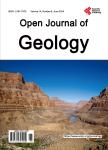Shallow Subsurface Stratigraphy Inferred from the Use of Vertical Electrical Soundings (VES) Survey in Central Chihuahua, Mexico
Shallow Subsurface Stratigraphy Inferred from the Use of Vertical Electrical Soundings (VES) Survey in Central Chihuahua, Mexico作者机构:Facultad de Ingeniería Universidad Autónoma de Chihuahua Chihuahua México
出 版 物:《Open Journal of Geology》 (地质学期刊(英文))
年 卷 期:2019年第9卷第1期
页 面:15-28页
学科分类:1002[医学-临床医学] 100214[医学-肿瘤学] 10[医学]
主 题:Geophysics Vertical Electric Soundings Geoelectrical Sections
摘 要:Vertical Electrical Soundings (VES) provide fast and economical measurements used in geophysical exploration. VES were carried out in El Sauz-Encinillas (ESE) aquifer, in northern Mexico, to determine apparent resistivity and geoelectrical units’ thickness. Despite it being one of the three main aquifers feeding Chihuahua city, a lack of available geophysical data prevails in its northern portion. The main goal of this study was the determination of the geoelectrical units in the subsurface stratigraphy via electrical-resistivity soundings. The ESE’ aquifer is located within alluvial Quaternary sediments, with varying granulometry and reaching from a few meters to more than 600 meters of thickness at the center of the valley. Forty-five vertical electrical resistivity soundings (Schlumberger array, maximum AB/2 distance of 500 m) were performed throughout ESE aquifer’s northern portion. Field data were analyzed using software. Results illustrate a wide variability in resistivity values throughout the study area. Five geoelectrical units were identified: 1) a hardpan topsoil, with resistivity values ranging from 200 - 800 Ω-m;2) an alluvial material mixture (sand/silt) with resistivity values ranging from 25 to 100 Ω-m;3) playa lake-type material (clay/evaporites mixture) with resistivity values ranging from 0.2 to 15 Ω-m;4) a gravel/sand mixture with resistivity values from 100 to 300 Ω-m;and 5) a partly fractured rock or conglomeratic material with resistivity values ranging from 400 to 3500 Ω-m. The electrical resistivity data, therefore gives reasonably accurate results that can be used to understand the subsurface stratigraphy and basement configuration in groundwater exploration.



